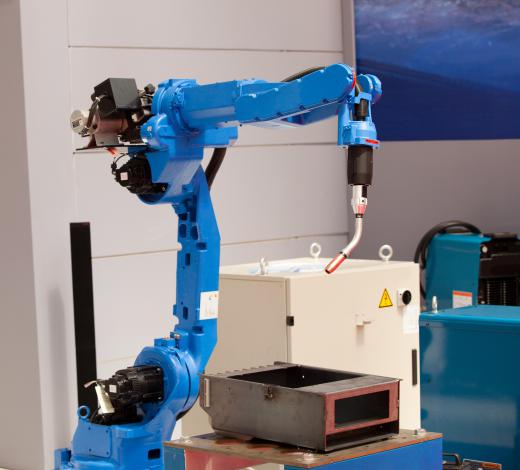A string potentiometer is a type of linear measuring device that uses a spring loaded cable or "string" on a spool. These typically generate an electric signal based on the amount of cable that is pulled from the spool. Sometimes called "string pots" for short, the string potentiometer is common in many technical applications.
These devices were first developed for the aerospace industry in the 1960s. This technology allows aircraft engineers to closely monitor the position of control surfaces, such as ailerons and rudders. The use of string pots reaches far beyond aircraft, however, and potentiometers are frequently used in industrial automation and robotic systems.

All types of potentiometers operate as variable resistors. This means that they are able to create many different amounts of electrical resistance, depending on their position. High levels of resistance slow the flow of electrical current, while low levels allow electricity to pass easily. Standard dimmer knobs on lights, for instance, are variable potentiometers that allow users to adjust the flow of current manually. A string potentiometer operates using the same principle.
The cable inside a string potentiometer is connected to a spring. As the end of the cable is pulled, it unwinds from the spool and causes the internal potentiometer to rotate. The spring return mechanism maintains tension on the cable in order to prevent slack, and also to pull the string back onto the spool when the end is released.
Applications that use string potentiometers typically have the spool mounted securely in one place. The end of the cable is usually connected to a moving object, such as a sliding hydraulic rod or the arm of an industrial machine. Electrical resistance from the internal potentiometer increases as the cable is pulled and decreases as it is returns.
Signals from a string potentiometer can be used in several ways. Computers and industrial controllers are able to read the level of resistance and convert it into a distance measurement. A computer readout, for example, can display the height of a hydraulic cylinder in centimeters or inches. The resistance level generated from a string potentiometer can also be used directly in an electrical circuit in order to toggle a device once a preset threshold is met.
Not all string potentiometers have the same amount of accuracy. Some use very precise internal potentiometers, and are able to measure distance variations of under a centimeter. Generally, more precise devices are also more expensive. Many are contained in protective cases, which allow them to operate in wet or dirty environments without becoming damaged.
